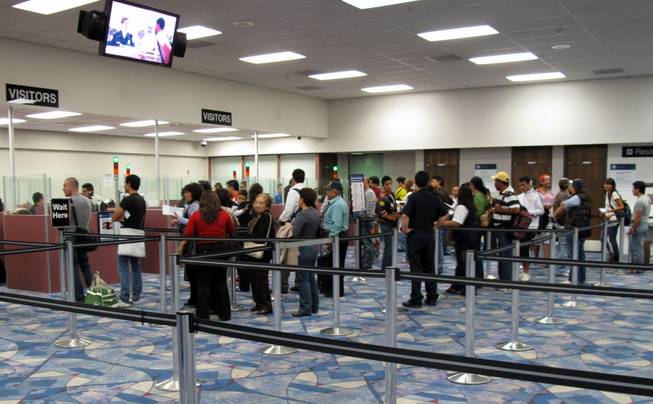
Travelers from an international flight wait in line at the passport check area at McCarran International Airport’s Terminal 2 on Wednesday, April 23, 2010.
Friday, Sept. 10, 2010 | 2:05 a.m.
Travelers who use McCarran International Airport aren’t going to have to wait for Terminal 3 to open in 2012 to get a look at the airport terminal of the future.
McCarran has been selected to participate in pilot programs for the self-tagging of bags at a central location and an automated self-boarding system at gates.
Sam Ingalls, assistant director of information systems at McCarran, said self-tagging and automated self-boarding will be available at McCarran at the end of the year.
Ingalls — who has helped Las Vegas’ airport set international standards in common-use terminal equipment and radio-frequency identification bag tags — moderated a panel Thursday on what air terminals of the future will look like. The panel was part of Check-In 2010, a three-day international aviation conference at the MGM Grand Conference Center.
Self-tagging of bags will enable customers who check in off-site, on the Internet or with a mobile device, to see a common agent for several air carriers, get a bag tag, attach it to the suitcase and drop it off.
Automated self-boarding systems will enable customers at gates to scan their boarding passes, PDAs with two-dimensional bar codes and some phone screens with a device near the jet bridge to the plane.
The scanned document or device will have its information matched against the airline’s departure control system and enable the passenger to board at the proper time. The mechanism is similar to the gateways in modern subway and rapid transit systems.
Panelists discussing the look of future air terminals stressed conveniences that will be brought about by technology, while the architects said a sense of place and the experience of the journey would drive the look of future airport terminals.
The primary goal is to be business friendly, family friendly and entertaining while removing the anxiety of check-in and congestion.
But panelists also concluded that one type of airport terminal would not fit all destinations and flexibility will be the key to terminal design.
For example, McCarran is one of the nation’s busiest origination and destination airports and will have different needs than an airport like Hartsfield-Jackson Atlanta International Airport, which has far more passengers transferring from one flight to another because it is a hub for Delta Air Lines.
McCarran also is more likely to have amenities geared for leisure travelers than business travelers. Ingalls said Terminal 3 likely would have more dynamic signage and interactive way-finding technology.
Some critics have complained that there aren’t enough directional signs at McCarran and the international Terminal 2 has few foreign language signs.
“In any complex environment like an airport is — it’s a small city — there are going to be challenges for helping customer find where they need to go,” Ingalls said.
Ingalls said McCarran is ahead of the curve for technology and looks to expand its acclaimed WiFi network.
The airport intends to spread the wireless network to the ramp to enable back-of-the-house communications, and new jet bridges are coming with antennae for the network and prewired connecting points.
Automated aircraft docking technology to minimize damage to planes and equipment also is planned.
Panelist Rob Ranieri, a partner with IBM Business Services, said his company is developing “smart terminal” technology that includes enhanced baggage scanning equipment, digital video surveillance systems and biometric scanners to speed the security check process.
He also suggested that the aviation industry is considering permanent bag tags with chips that can be scanned built into suitcases.
Panelist Cees de Vos, director of airport services for the SkyTeam Alliance of airlines, said biometric travel documents will someday automate border control checks and result in walk-by security checks.
The architects on the panel applauded both technological and design innovations at London Heathrow International Airport’s new Terminal 5, Hong Kong International Airport and Singapore’s Changi International Airport.
David Holm, principal architect for Woodhead, said the Singapore airport’s arrivals area includes a vine-covered wall characterizing the tropical atmosphere of the region, and the retail area of Sydney International Airport offers a seamless entry experience for travelers.
Advancements in aircraft technology also will drive some airport design as some airports have developed double-deck gate lounges to accommodate passengers flying on massive double-decked Airbus A380 jets.
Ingalls also said airlines are learning more about their customers, which is resulting in some operational changes at airports.
“It used to be that the thinking was that the premium customer always wanted that extra personal touch,” Ingalls said.
But special treatment is no substitute for getting through check-in lines faster.
“A passenger would say, ‘I’m standing on my red carpet, but why am I in line and not able to check in at the kiosk right over there? I have a ticket that says ‘Premium’ and I appreciate the red carpet. But you know what I really want to do is be at the gate or at the lounge.’”

Join the Discussion:
Check this out for a full explanation of our conversion to the LiveFyre commenting system and instructions on how to sign up for an account.
Full comments policy